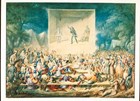A place-based learning resource, the series explores the 1848 Seneca Falls Convention where women made demands for equality. You'll find chapters (with readings, discussion questions and activities) about reform movements, the planning of the convention, and the role of the M'Clintock Family. Chapters 2-4 (and associated activities) can be used independently or as a whole. The material can be used in a formal classroom setting (curriculum standards included) or by those curious to learn more.
-
Article 1: The M'Clintock House & Women's Rights: Opportunities for Learning (1: Introduction)
Before the Civil Rights movements of the 20th century, American women of every race and class did not have the Constitutional right to vote, the right to serve on juries, and equal status before the law as their male peers. It took over a century of activism to achieve those rights and that activism can be traced back to 1848, when advocates for equality held the Women’s Rights Convention in Seneca Falls, New York. Read more
-
Article 2: The M'Clintock House & Women's Rights: Opportunities for Learning (2: Social Movements and Early Settlement)

Reform movements of the early 1800s spurred the settlement of territory in the United States. Learn about how religious revival movements informed the women's suffrage movement. Read more
-
Article 3: The M'Clintock House & Women's Rights: Opportunities for Learning (3: The M'Clintocks and Women's Rights)

Learn about how women leaders like Elizabeth Cady Stanton met at the M’Clintock House in New York to draft the famous Declaration of Sentiments. In this historic document, women articulated their demand for voting rights. Discover educational opportunities and learn more about women’s rights. Read more
-
Article 4: The M'Clintock House & Women's Rights: Opportunities for Learning (4: Present-Day M'Clintock House)

Built in 1836, the M'Clintock House was home to Thomas and Mary Ann M'Clintock and their children. They lived there for 20 years. The house saw many reform movements discussed and debated under its roof, including women's rights, abolition, and temperance. Learn more about the house and find fun activities relating the women's suffrage. Read more

